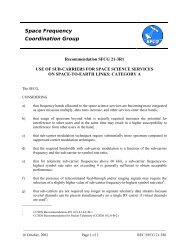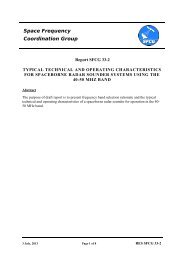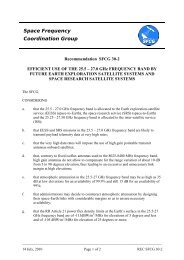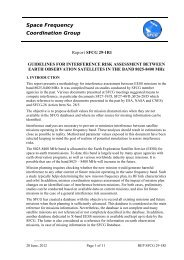Space Frequency Coordination Group - SFCG
Space Frequency Coordination Group - SFCG
Space Frequency Coordination Group - SFCG
- No tags were found...
Create successful ePaper yourself
Turn your PDF publications into a flip-book with our unique Google optimized e-Paper software.
<strong>Space</strong> <strong>Frequency</strong><strong>Coordination</strong> <strong>Group</strong>Resolution <strong>SFCG</strong> A12-1R3ESTABLISHMENT OF PROCEDURES FOR INTER-AGENCYFREQUENCY COORDINATIONThe <strong>SFCG</strong>,CONSIDERINGa) that the increasing congestion of frequency bands allocated to the space scienceservices calls for an efficient coordination procedure to facilitate individualfrequency assignments and to reduce the potential for mutual interference;b) that the coordination procedure contained in Article 9 of the ITU Radio Regulationsdoes not always provide the desirable flexibility to facilitate inter-agencycoordination of frequency assignments;c) that member agencies could make use of the methods contained in the annex to thisResolution to coordinate frequency utilization which may not be readily applicable inArticle 9 of the Radio Regulations;d) that some member agencies, for many years, have used with great success interagencyprocedures to facilitate coordination of frequency assignments;e) that the principles underlying these procedures have found to be effective and mayalso prove useful in inter-agency coordination of frequency assignments amongmember agencies in general;f) that inter-agency coordination based on a format common to member agencies willease the application of the procedural methods;g) that nevertheless the provisions of Article 9 of the Radio Regulations provides theformal coordination mechanism to be used between administrations when applicable;RESOLVES1. that those member agencies wishing to undertake inter-agency frequencycoordination with other member agencies give due consideration to the use of theprocedures contained in the annexed <strong>SFCG</strong> Manual of Procedures for Inter-Agency<strong>Frequency</strong> <strong>Coordination</strong> as a template for development of bilateral and/ormultilateral agreements;___________________________________________________________________________23 September, 2008 Page 1 of 18 RES <strong>SFCG</strong> A12-1R3
2. that member agencies involved in coordination utilize the <strong>SFCG</strong> database andprovide updated information, if appropriate;3. that pre-coordination of a system may begin before that system is entered in the<strong>SFCG</strong> database;4. that a member agency will consider a final coordination request from another agencywhen that agency has entered necessary technical data in the <strong>SFCG</strong> database forcoordination to proceed based on that technical data. 11 This information will include orbit type, altitude, inclination, eccentricity, and if sun-synchronous, sunangle, all earth stations’ latitudes and longitudes, all carriers’ frequencies, bandwidth, transmit power,power spectral density, transmit antenna gain, and system point of contact name and email.___________________________________________________________________________23 September, 2008 Page 2 of 18 RES <strong>SFCG</strong> A12-1R3
<strong>Space</strong> <strong>Frequency</strong><strong>Coordination</strong> <strong>Group</strong><strong>SFCG</strong> MANUAL OF PROCEDURES FORINTER-AGENCY FREQUENCY COORDINATION___________________________________________________________________________23 September, 2008 Page 3 of 18 RES <strong>SFCG</strong> A12-1R3
(Annex to RES <strong>SFCG</strong> A12-1R2 of 20 October, 2005)TABLE OF CONTENTS1. Purpose ....................................................................................................... 12. Scope ....................................................................................................... 13. Procedural Approach .......................................................................................... 13.1 Advance Planning Phase .......................................................................... 13.1.1 Description of Responsibilities ...................................................... 13.1.2 Interfaces........................................................................................ 33.1.3 Advance Planning Procedure ......................................................... 43.2 Post-Launch Operations Phase ................................................................. 73.2.1 Description of Responsibilities ...................................................... 73.2.2 Interfaces........................................................................................ 73.2.3 Operations <strong>Coordination</strong> Procedure ............................................... 74. Priority Guidelines .............................................................................................. 95. Extension and Cancellation of <strong>Frequency</strong> Assignments..................................... 96. Data Set Specifications for Advance Planning Phase ......................................... 97. Revision and Amendment Control ..................................................................... 108. Applicable Documents ....................................................................................... 10Annex 1: Flow Diagram of Advance Planning Phase___________________________________________________________________________23 September, 2008 Page 4 of 18 RES <strong>SFCG</strong> A12-1R3
1. PURPOSEMember Agencies of the <strong>SFCG</strong> share certain radio frequency bands allocated to space services ofcommon interest to these Agencies. As a consequence of this, it is essential that advance planningand post-launch operational coordination be carried out by these Agencies with a view to minimizeradio spectrum interference between their missions.This manual defines a method and execution of Inter-Agency frequency coordination that may beconsidered among consenting <strong>SFCG</strong> member agencies.2. SCOPEThis Manual defines coordination activities associated with the use by <strong>SFCG</strong> Member Agencies ofthe relevant frequency bands allocated to Earth-to- <strong>Space</strong>, <strong>Space</strong>-to-Earth or <strong>Space</strong>-to-<strong>Space</strong> radiocommunicationsin the Radio Regulations of the International Telecommunications Union (ITU),supplemented by <strong>SFCG</strong> Recommendations, where applicable.These activities will basically consist of advance planning and operational coordination withrespect to the use of relevant frequency bands by <strong>SFCG</strong> member agency missions and earth stationsor by programs in which these Agencies participate. Consideration will also be given to otherfrequency bands when unwanted emissions are likely to occur.3. PROCEDURAL APPROACH3.1 Advance Planning PhaseThe discovery of radio interference between active space missions or a potential interferencecondition in a finalized mission design may result in burdensome emergency solutionsinvolving costly engineering changes and/or constraints on mission operations andobjectives.The initiation of advance planning of frequency use at the very early stages of a missiondesign is motivated by recognition of the following facts:- The mutual coordination of frequency use is, by its very nature, rather timeconsuming.- The implementation of design modification that may be required in the course ofthe coordination procedure becomes increasingly more difficult as the projectadvances through its design and qualification stages.Consequently, even very preliminary information made available during the early phases ofmission design can be most helpful in identifying potential areas where frequency conflictsmay occur. This can lead to joint remedial action by the Agencies concerned to affectminimum cost and inconvenience to the Projects concerned.___________________________________________________________________________23 September, 2008 Page 5 of 18 RES <strong>SFCG</strong> A12-1R3
3.1.1 Description of ResponsibilitiesIn order to carry out advance planning of frequency utilization during the preparation for,and conducting of, multiple simultaneous flight missions, the Agencies will assume thefollowing responsibilities:A. Identify, at the earliest possible stage of system design development, spacemissions susceptible to interference from, or likely to cause interference to theother Agency's space operations.B. At the earliest possible stage, provide to the other Agency information aboutproposed use of frequencies in, or adjacent to, the space service frequency bands.C. In the event that a potentially serious conflict is identified, the Agencydiscovering the conflict will identify areas which can facilitate coordinationbetween the Agencies and notify the other Agency of relevant informationResolution of interference cases, following the conclusion of advance planning phasespecified in paragraph 3.1.3, will, at the same time, meet the technical informationrequirements of the official frequency coordination procedures (when applicable) set forth inthe appropriate sections of Article 9 of the ITU Radio Regulations.Consequently, the activities carried out between the Agencies during the advance planningphase will greatly facilitate - and thereby shorten - the official coordination in accordancewith Article 9, Section II of the ITU Radio Regulations (when applicable). It can, however,not replace the formal (administrative) exchange of information required by said provisionbetween the Radio Regulatory Authorities, responsible for the notification of the respectivesatellites.3.1.2 InterfacesAgency:Network:The interfaces in the Agencies, for the activities carried out in the advance planning phase arelisted in Table 3.1.TABLE 3.1Name of Contact:Function:Address:Phone:INTERFACES FOR THE ADVANCE PLANNING PHASE___________________________________________________________________________23 September, 2008 Page 6 of 18 RES <strong>SFCG</strong> A12-1R3
Fax:Telex:3.1.3 Advance Planning ProcedureThe following procedure defines the framework within which the advance planning offrequency use will be carried out. The procedure for advance planning of frequency use is alsooutlined in a flow diagram (Annex 1, Figure 3.1). Deadlines for completion of the varioustasks are indicated as a guideline. However, personnel with authority to conduct the indicatedtasks are invited to make every effort to reduce the overall duration of the procedure.Step 1:Initial Announcement of Intended Use of <strong>Frequency</strong> BandsObjective: Initiation of procedure for advance planning phaseResponsibility: Agency A (announcing Agency)The preliminary exchange of mission information prior to, or during the missiondefinition phases should take place at the earliest possible time even though someof the required information may be tentative or incomplete. Tentative orincomplete information should be clearly identified in the preliminary exchange ofinformation.Agencies will exchange, as soon as available and if possible, at least three (3)years prior to the scheduled launch date, summary-type information on missiondesign, mission objectives, trajectory/orbit data, scheduled launch time, missionlifetime 2 . <strong>Frequency</strong> information should include the allocated frequency bandsthat will be used, the planned centre frequencies, and occupied bandwidths. Toexpedite the coordination procedure, alternative frequency bands should beincluded whenever possible.Step 2:Preliminary Assessment of Potential InterferenceObjective: Request for identification of interferencepotentialsResponsibility: Agency B2 The data set for preliminary examination of potential interference is described in Section 6.1.___________________________________________________________________________23 September, 2008 Page 7 of 18 RES <strong>SFCG</strong> A12-1R3
Upon receipt of the preliminary coordination data forwarded by the announcingAgency (Agency A), the recipient Agency (Agency B) will promptly (preferablywithin one week) acknowledge receipt and proceed to examine the material withregard to interference which is likely to be caused to, or by, its missions and/or theservices rendered by its networks(s) in operation.Within approximately one month from the acknowledged date of receipt of thecoordination data, the recipient Agency should notify the announcing Agency ofits preliminary assessment on interference potentials. If a preliminary assessmentis not possible, the recipient Agency should indicate the reasons and suggestremedies that would allow assessment to proceed. The announcing Agency willacknowledge receipt (preferably within one week) of this preliminary assessmentof interference potentials and provide a response to the other Agency within aperiod of 1 month regarding the preliminary assessment .Within the framework of pre-flight planning and mission analysis, the informationexchanged may include, but not be limited to, the following:- Provision of relevant trajectory/orbit and telecommunication linkspecifications for those missions which have been identified as susceptibleto interference from, or to be sources of interference to, space operations ofthe other Agency. This information will consist as a minimum of thatrequired in Appendix 4 of the Radio Regulations.- Analysis and prediction of the extent of Interference to the discoveringAgency's space operations.- Performance of simulations and/or ground tests, if required and feasible, todetermine the susceptibility to interference conditions of the missionoperations system.- Definition of critical operational phases for those missions which have beenidentified as being susceptible to interference.- Development, jointly with the other Agency, of criteria for temporarilyturning off telecommunications links, or other measures for avoidinginterference.Step 3:Detailed Examination of Potential Interference(if required)Objective: Joint in-depth investigation of potential interferenceResponsibility: Agencies A and BThe Detailed Examination is to be performed simultaneously by the Agenciesconcerned for all missions identified as having interference potential. Since thiswork requires additional resources and support from numerous internalorganizations, the following procedure will be followed:A. If more than two missions (i.e. one "mission pair") are involved in an interference___________________________________________________________________________23 September, 2008 Page 8 of 18 RES <strong>SFCG</strong> A12-1R3
case, it may be advisable to develop a cross-reference matrix containing theAgency A and B mission pairs which are identified in Step 2 as havinginterference potentials. It is left to the mutual decision of the agencies involved todevelop such a matrix.B. The matrix should identify those missions requiring priority analysis together withthe completion dates.C. After priorities for the Detailed Examination have been mutuallyestablished, a detailed analysis of the high priority mission pair will be initiated bythe agency that suspects interference will be experienced from the other agenciestransmitters. For example, if Agency B suspects potential interference fromsignals radiated by the proposed transmitters of Agency A, Agency B will performthe Detailed Examination of the interference potential. Agency B will request thebaseline information contained in Data Set Specifications for Advance Planning of<strong>Frequency</strong> Use as outlined in Section 6 of this document. This information will beprovided by the suspected interferer Agency.The Data Set will be furnished by Agency A within approximately one month andAgency B should complete the detailed examination within a period of twomonths. The result of this examination will be forwarded to Agency A forconcurrence of the findings. This concurrence should be provided within onemonth after the receipt of the Detailed Examination.The anticipated rate and duration of potential interference occurrences should beestimated for the period between the scheduled launch of the new mission to theend of its normal mission lifetime. However, in order to accommodate possiblelaunch delays and/or extensions of the mission lifetime, the end date of the normalmission lifetime should be appropriately extended for the purpose of interferenceavoidance planning.Step 4:Joint Analysis and/or Test/Simulations (if required)Objective: Joint attempt to identify solution(s) of interference problemResponsibility: Agencies A and BIn case Agency B, in Step 3, had not succeeded in resolving the interference problem, but regards asbeneficial joint analysis and/or tests/simulations with A, it shall inform the latter within two weeks ofits intent to initiate Step 4. This announcement shall, if possible, already include a technical outlinefor the proposed joint analysis and/or test/simulations program.Step 5:Initiation of Remedial Action (if required)Objective: Implementation of solutions to interference problemsResponsibility: Agency A and/or BIf the results of Step 4 have established the existence of unacceptable interference,___________________________________________________________________________23 September, 2008 Page 9 of 18 RES <strong>SFCG</strong> A12-1R3
the Agencies will jointly determine whether there are feasible engineering orprocedural solutions for solving or reducing the problem. Any mutuallyacceptable engineering solution(s) will be implemented immediately. In theabsence of engineering solutions, the Agencies concerned will determine whetherpost launch operational procedures can be adequately coordinated or modified toalleviate the interference problem.If adequate post-launch operations coordination can alleviate the interferenceproblem the Agencies concerned will apply the general operations coordinationprocedures, called up in 3.2.3. They will jointly develop mission- specificoperations coordination procedures, to be implemented for post-launch operations.The responsibility for the development and implementation of these operationsrelatedactivities rests with the offices identified in Table 3.2. The officesidentified in Table 3.1 will be kept informed on the progress made in thedevelopment of the mission-specific operations procedures.3.2 Post-Launch Operations Phase3.2.1 Description of Activities3.2.2 InterfacesIn all cases in which Step 5 of the advance planning procedure (paragraph 3.1.3) resolvesthe interference problem through the implementation of mission-specific coordinatedoperations procedures, the responsible Agency Operations Offices identified in Table 3.2shall:- Establish general operations coordination procedures for the satellites networksconcerned, as required.- Establish mission-specific operations procedures with the framework of thegeneral operations coordination procedures as required.- Schedule mission operations support so as to minimize disruptive RFI.- Coordinate the resolution of immediate operations problems as necessary.- Notify its Agency <strong>Frequency</strong> Manager of major interference cases, thecircumstances involved, the action taken, and whether any additional action isrequired.The Agency interfaces for the execution of post-launch operations coordination are listedin Table 3.2.3.2.3 Operations <strong>Coordination</strong> ProcedureGeneral operations coordination procedures by which Agencies concerned exchangeoperational information for the resolution of possible and/or actual Radio <strong>Frequency</strong>___________________________________________________________________________23 September, 2008 Page 10 of 18 RES <strong>SFCG</strong> A12-1R3
Interference (RFI) problems will be developed, as required, by the offices identified inTable 3.2.The general operations coordination procedures may be complemented by missionspecificoperations procedures, if required.General and mission-specific operations coordination procedures do not form part of thisManual.TABLE 3.2INTERFACES FOR POST-LAUNCH OPERATIONS COORDINATIONAgency:Network:Name of Contact:Function:Address:Phone:Fax:Telex:4. PRIORITY GUIDELINESThese priority guidelines apply in the case of interference, actual or potential, involving spacemissions of <strong>SFCG</strong> Member Agencies. They are meant as a tool for the treatment of interference casesin the framework of the mission specific operations coordination procedure described in 3.2.3.Priority 1 (Critical) – Interference events that jeopardize humans actively engaged inspace mission activity.Priority 2 (Critical) – Interference events that jeopardize spacecraft safety, especiallyduring time of a declared spacecraft emergency.Priority 3 (Critical) – Interference events that jeopardize the successful completion ofthe mission objectives, i.e., objectives that are time-critical and can neitherbe revoked nor re-scheduled.Priority 4 (Semi-Critical) – Interference events that could jeopardize scheduledtime-critical mission objectives having limited opportunities for rescheduling.Priority 5 (Routine) – Interference events that jeopardize mandatory mission___________________________________________________________________________23 September, 2008 Page 11 of 18 RES <strong>SFCG</strong> A12-1R3
objectives with subsequent opportunities for re-scheduling.5. EXTENSION AND CANCELLATION OF FREQUENCY ASSIGNMENTThe Agencies concerned will inform each other, at the earliest possible date of any:- Intended extension of the use of a frequency band beyond the previously scheduledtermination,- Predicted or unscheduled cancellation of a frequency assignment.This information, which is vital to the orderly execution of advance planning phase and theconscientious management of the limited frequency resources, shall be forwarded between the officesidentified in Table 3.1, Paragraph 3.1.2. It will also be duly reflected in the <strong>SFCG</strong> Satellite Data Baseentries for the spacecraft concerned.6. DATA SET SPECIFICATION FOR ADVANCE PLANNING OF FREQUENCY USEThe specification of the required Earth-to-<strong>Space</strong>, <strong>Space</strong>-to-Earth and <strong>Space</strong>-to-<strong>Space</strong> radio link dataset necessary to establish radio spectrum interference potentials are listed in this section.6.1 Data Set for Preliminary Examination of Potential Interference (3.1.3 Step 2)The data set for the preliminary examination of potential interference shall be supplied usingthe format of the <strong>SFCG</strong> Satellite Data Base.6.2 Data Set for Detailed Examination of Potential InterferenceThis data set shall be an expanded version of the one described in 6.1. Its contents shall bedefined by the offices defined in Table 3.1 on a case by case basis.7. REVISION AND AMENDMENT CONTROLThe <strong>SFCG</strong> Procedures Manual for Inter-Agency <strong>Frequency</strong> <strong>Coordination</strong> shall be subject to additions,deletions and amendments, as the need arises, by agreement among <strong>SFCG</strong> Members. The authorityfor revisions will rest with the <strong>SFCG</strong>.The execution of the revision will rest with the Executive Secretary of the <strong>SFCG</strong>.8. APPLICABLE DOCUMENTS- ITU/Radio Regulations (current)___________________________________________________________________________23 September, 2008 Page 12 of 18 RES <strong>SFCG</strong> A12-1R3
- Final Acts of most recent WRC- Radio Regulations Board: Rules of Procedure- Preface to Radiocommunication Bureau International <strong>Frequency</strong> Information Circular(<strong>Space</strong> Services) (BR IFIC) (http://www.itu.int/ITU-R/space/preface/index.html)- <strong>SFCG</strong> Resolutions and Recommendations___________________________________________________________________________23 September, 2008 Page 13 of 18 RES <strong>SFCG</strong> A12-1R3
Annex 1Flow Diagram of Advance Planning Phase___________________________________________________________________________23 September, 2008 Page 14 of 18 RES <strong>SFCG</strong> A12-1R3
STEP 1: InitialAnnouncementof Intended<strong>Frequency</strong>AssignmentsResponsibility:Agency ATransmission of Information on PlannedUse of Frequencies and on PossibleAlternative FrequenciesAs Early as Possible(At Least 3 YearsPrior to Launch)STEP 2: PreliminaryAssessmentExamination ofPotentialInterferenceResponsibility:Agency BAcknowledgement of Receipt of<strong>Frequency</strong> PlansOne WeekPreliminary AssessmentExamination of InterferencePotentialApproximatelyOne MonthNoInterferenceIdentified?YesAInform Agency A<strong>Frequency</strong> ManagerAnd Flight MissionsConcernedInform Agency A<strong>Frequency</strong> ManagerAnd Flight MissionsConcernedEnd of ProcedureFigure 3.1 Advance Planning PhaseFlow Diagram (Sheet 1 of 4)___________________________________________________________________________23 September, 2008 Page 15 of 18 RES <strong>SFCG</strong> A12-1R3
ASTEP 3: DetailedExamination ofPotentialInterferencesResponsibility:Agency A and BInterferor AgencyFurnishes Required DataSet to Interferee AgencyOne MonthInterference AgencyPerforms DetailedExaminationTwo MonthsExamination ResultsForwarded to InterferorAgency for ConcurrenceOne MonthYesInterferenceAcceptable?NoAcceptable Minor InterferenceOr None Exists; No FurtherAction RequiredYesTests/SimulationsRequired?NoInform Agency<strong>Frequency</strong> Managersand Flight MissionsConcernedBCEnd of ProceduresFigure 3.1 Advance Planning PhaseFlow Diagram (Sheet 2 of 4)___________________________________________________________________________23 September, 2008 Page 16 of 18 RES <strong>SFCG</strong> A12-1R3
Note: Step 4 can be omitted whenInterference Tests/Simulationsare not necessaryBSTEP 4: Analysis and/orTests/SimulationsResponsibility:Agency A and BAgency A or B RequestsSpecific Analyses and/orTests/SimulationsTwo WeeksJoint Execution of AgreedAnalyses and/or Tests/SimulationsYesInterferenceAcceptable?NoVerification of MutualAcceptance of InterferencePotentialCInform Agency<strong>Frequency</strong> Managersand Flight MissionsConcernedEnd of ProceduresFigure 3.1 Advance Planning PhaseFlow Diagram (Sheet 3 of 4)___________________________________________________________________________23 September, 2008 Page 17 of 18 RES <strong>SFCG</strong> A12-1R3
CNoEngineeringWork-Around?YesSTEP 5: Initiation ofRemedial ActionsResponsibility:Agency A and BNoOperationalWork-Around?YesPlan for, Execute, andVerify EngineeringWork-AroundInform Agency<strong>Frequency</strong> Managersand Flight MissionsConcernedAgencies A and B InitiateMission-Specific OperationsProceduresTwo WeeksInform Agency<strong>Frequency</strong> Managersand Flight MissionsConcernedFlight Missions and NetworksDevelop Mission-SpecificOperations ProceduresEnd of ProceduresInform Agency<strong>Frequency</strong> Managersand Flight MissionsConcernedEnd of ProceduresFigure 3.1 Advance Planning PhaseFlow Diagram (Sheet 4 of 4)___________________________________________________________________________23 September, 2008 Page 18 of 18 RES <strong>SFCG</strong> A12-1R3
















